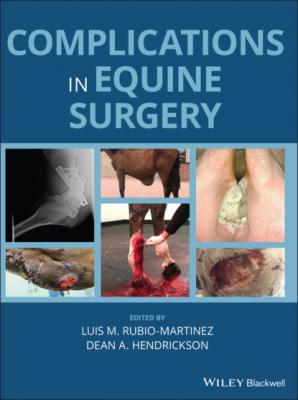Complications in Equine Surgery. Группа авторов
Читать онлайн.| Название | Complications in Equine Surgery |
|---|---|
| Автор произведения | Группа авторов |
| Жанр | Биология |
| Серия | |
| Издательство | Биология |
| Год выпуска | 0 |
| isbn | 9781119190158 |
Excessive postoperative bleeding is a rare complication which could occur as a result of necrosis of the wall of an intact vessel that was frozen together with the tumor (e.g. saphenous vein for sarcoids on the inner aspect of the thigh). The author has not experienced this complication yet, most likely because coagulation necrosis of the frozen tissue also results in vessel thrombosis before rupture of the wall would occur.
Diagnosis
Obvious hemorrhage from the surgical site
Prevention
When tumors are debulked or a preoperative biopsy is taken, care should be taken to achieve good hemostasis (e.g. using radiofrequency electrocoagulation).
When treating lesions are resting directly over a large superficial vein, the latter can be ligated proximally and distally to prevent hemorrhage when the tissue sloughs [14].
Contact probes should be allowed to detach spontaneously from the tissue during the thawing phase. Avulsion of the probe can precipitate unnecessary bleeding because of tissue tearing [1].
A pressure bandage can be applied over the site for the first 24 hours to prevent hemorrhage [14].
Treatment
Management of postoperative bleeding consists in providing hemostasis, either by clamping and/or suturing the vessel or by applying a pressure bandage.
Expected outcome
The prognosis is good because postoperative bleeding after cryosurgery is never life‐threatening.
Excessive Local Edema and Pain
Definition
The development of serious local swelling due to excessive oedema formation at the site of cryosurgery
Risk factors
Tumoral masses with a (very) large base
Dependant antomical locations (ventral abdomen, chest, prepuce, etc.)
Pathogenesis
Local edema develops almost immediately after thawing (Figures 11.2a, b) and results from the vascular damage in the frozen tissue. It augments in the next 24–48 hours with subsequent gradual resolution over the following days (up to 1 week) [13]. This is more obvious in dependant anatomical locations more prone to develop edema such as ventral abdomen, ventral chest, prepuce or distal limbs. Cryosurgery of limbal squamous cell carcinomas also results in some corneal edema and corneo‐conjunctival inflammation [5]. This is considered to be normal.
When treating very large tumors, the amount of tissue necrosis after freezing can be very extensive, resulting in excessive local swelling and associated pain. In some cases, local infections or lymfangitis may develop [13, 14].
Ocular pain evident as blepharospasm and/or miosis has been observed in 4 out of 10 horses treated with cryosurgery for limbal squamous cell carcinomas [5].
Diagnosis and monitoring
Obvious oedematous swelling at the site of cryosurgery
Figure 11.2 Equine sarcoid on the medial aspect of the right elbow of a horse before (a) and after (b) cryosurgery using a liquid nitrogen circulation probe. The tumor has been debulked at the base and 1 freeze‐thaw cycle has already been applied resulting in pronounced edema, which will even increase after the second freeze‐thaw cycle. This is not a complication but a normal biological response after cryosurgery. Note the thermocouple needles inserted at the periphery of the lesion to ensure a sufficiently low temperature.
Source: Ann Martens.
Prevention
Application of a compressive bandage immediately after cryosurgery will limit the development of oedema. This is recommended for cryosurgery of large masses at the level of the distal limbs but is technically challenging or impossible at other locations (e.g. axilla, prepuce, inguinal region, chest, etc.).
Treatment
Excessive local swelling and pain can be managed by strong analgesic and anti‐inflammatory medication and the application of bandages at the distal limbs.
Management of excessive ocular pain includes non‐steroidal anti‐inflammatory medication and topical application of 1% atropine [5].
Expected outcome
The oedema commonly resolves in 1 to 2 weeks.
Excessive Tissue Necrosis
Definition
Formation of too much tissue necrosis resulting in undesired damage of underlying or surrounding tissue and resulting in functional impairment
Risk factors
Cryosurgery without temperature control
Tumors located over joints and tendons sheahs, or close to the coronary band [14, 15]
Cryosurgery of ocular lesions [14, 15]
Pathogenesis
Necrosis and sloughing of the frozen tissue start from 7–10 days after cryosurgery and are commonly accompanied by a yellowish exudate and a malodourous smell which disappears once all necrotic tissue has been fully rejected (Figure 11.3). This is a normal evolution after cryosurgery. However, overly aggressive freezing results in necrosis of too much healthy tissue and may damage vital structures surrounding the tumor. This results in unwanted tissue necrosis and sloughing of neighboring tissue, which is one of the most serious complications after cryosurgery.
Prevention
Tumors for which cryosurgery is feasible should be carefully selected by determining the risk of damaging important surrounding or underlying structures. Thermocouple needles should be aplied into the tissues to be preserved around the lesion [13] and these tissues should not be cooled below 0 to –5°C. The risk of inadvertent freezing of vessels at the edge of the lesion is relatively low as the circulating blood is a source of heat, thus delaying the development of very low temperatures.
Figure 11.3 Sloughing of the cryonecrotic eschar 3 weeks after cryosurgery of a sarcoid at the inner aspect of the right thigh, with the normal accompanying mucopurulent discharge.
Source: Ann Martens.
The use of cryosurgery has been discouraged for periocular sarcoids as they are commonly located on or very
